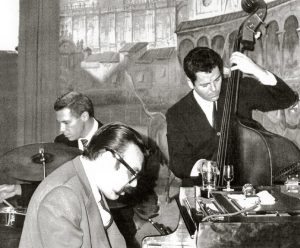By Donato Cabrera│medium.com/@donatocabrera
December 15, 2020

Vince Guaraldi Trio
One of the great contributions to U.S. culture by Bay Area luminaries Charles Schulz, Lee Mendelson, and Vince Guaraldi, A Charlie Brown Christmas — both its animation and music — is in the pantheon of must-sees during the holiday season, alongside A Christmas Story, Miracle on 34th Street, How the Grinch Stole Christmas, and It’s a Wonderful Life.
Vince Guaraldi was born in San Francisco in 1928 and was raised in North Beach. He attended Lincoln High School and San Francisco State and served as a cook in the U.S. Army in the Korean War. The music of the bohemian and beatnik culture of 1950’s San Francisco was jazz, and Guaraldi was a leading force. In 1953, Guaraldi became the pianist for the Cal Tjader Trio but by 1955 he had formed his own trio.
Guaraldi’s first success was not the music he wrote for the Charlie Brown projects but for a track from his 1962 album Jazz Impressions from Black Orpheus called, Cast Your Fate to the Wind. While Guaraldi’s version achieved a certain amount of success and won him the Grammy for Best Original Jazz Composition, a cover version in 1963 by the British group Sounds Orchestral got into Billboard’s Top Ten. Cast Your Fate to the Wind is one of the inspiring and uplifting tunes I know —
It was hearing Cast Your Fate to the Wind on the radio after a meeting with Charles Schulz that led Lee Mendelson to hire Guaraldi to compose music for the 1964 documentary, A Boy Named Charlie Brown. Within weeks, Guaraldi had composed several numbers and was so excited about the iconic tune Linus and Lucy that he insisted on playing it for Mendelson over the phone! Schulz and Mendelson immediately re-engaged Guaraldi to write the score for the 1965 A Charlie Brown Christmas. Thus began one of the most successful and identifiable collaborations between music and animation, a partnership that would last until Guaraldi’s untimely death at age 47 in 1976. Mendelson later said of Guaraldi’s music,
I have always felt that one of the key elements that made A Charlie Brown Christmas was the music. It gave it a contemporary sound that appealed to all ages. Although Vince had never scored anything else and although I was basically a documentary filmmaker at the time, we started to work together on the cues because we both loved jazz and we both played the piano. So he would bring in the material for each scene and we would go over it scene by scene. Most of the time, the music worked perfectly. But there were times we would either not use something or use it somewhere else. We went through this same process on all sixteen shows. Although there was always some left over music, most of the time what he wrote and performed is what went on the air.
